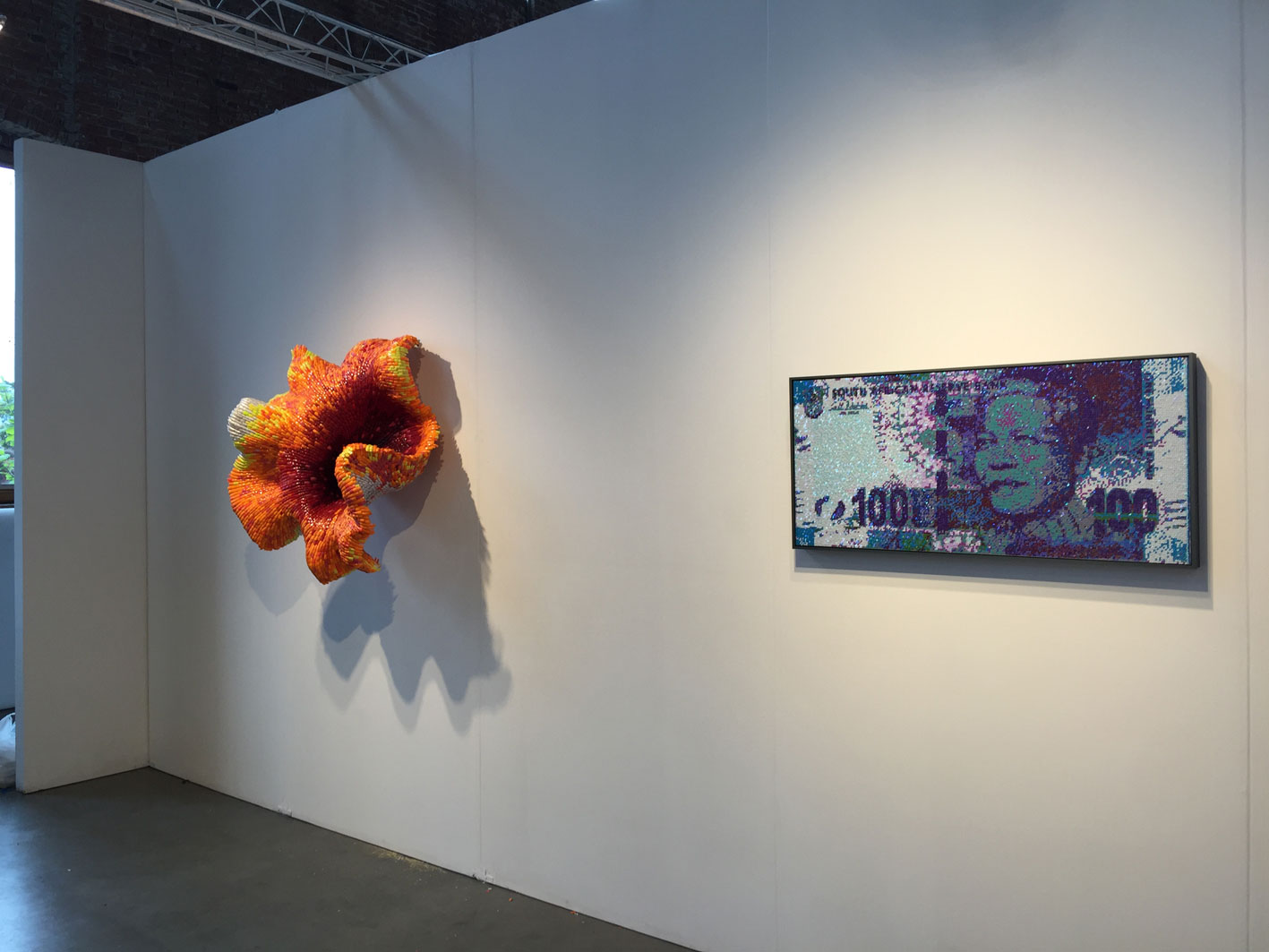
Transmogrified
Richard Taittinger Gallery is thrilled to announce TRANSMOGRIFIED, the third New York solo exhibition by acclaimed South African artist Frances Goodman. We asked Frances to tell us about her exciting new show and body of work:
“Transmogrify” means to “transform in a surprising or magical manner”. That is the process that I wanted to explore, in both the subject matter of and the way I use my materials, in my upcoming third solo exhibition at Richard Taittinger Gallery titled Transmogrified.
The genesis of the new series of sequin paintings for the exhibition lies in the work I did during the 2020 lockdown. Unable to work with other people in a live environment, I turned to the social media platforms available to me.
The extreme makeup/makeover trend – already popular even before the lockdown – rose to new heights during it because people were isolated at home with a lot of time on their hands. What appeared to start as a very niche and exclusive drag subculture moved into the mainstream. “Makeup has become a subculture all of its own. In communities centered around Instagram and YouTube, young people gather virtually to look for inspiration, swap product tips, and master tricky techniques.”
What is fascinating about this new subculture is that it is taking place in isolation; it is a solitary endevour. People are applying makeup in order to perform within the confines of their own homes, dressing up, taking a photo and then just removing it. The very essence of what it means to perform has changed. Instead of dressing up and preparing to step out in front of an audience, the act of dressing up has become the performance. The act of viewing and gratifying oneself is as important as the approval of the very removed audience.
People are becoming their own social media avatars “crossing the boundaries of reality to create extreme, experimental and obviously doctored versions of themselves... Suddenly, your identity is just the beginning of the story: it’s the catalyst to a whole." The makeup transformations can be beautiful or terrifying, monsterous or magical, and often play into old beauty stereotypes. The goal of the process appears to be the change itself: the masking, the concealing of one’s own identity to reveal something other, something new, something full of untamed potential, a visual depiction of an idea of oneself. The actor is also the product. Because sequins refract, reflect and change colour according to your viewpoint, I felt that using them to transform the portraits I had photographed would highlight this theme of metamorphosis. They add a magical, ‘unreal’ feel to the characters portrayed.
The rise in the makeup/makeover subculture also ties in with my own long-standing interest in the beauty industry, and how it uses people’s insecurites and aspirations to further its own financial ends. The current trend is premised on consumerism; it is consumerism as subculture. The people within this beauty subculture seem to use the trappings of the consumer industry in order to transform and empower themselves. But the beauty industry has in turn realigned itself to use the vogue to its advantage, by strategically supplying their products directly to the seemingly empowered (or perhaps commodotised) to experiment with on social media, thus cutting out the need to invest in advertising campaigns. The users themselves become the ultimate product placement, proving by example the effectiveness and desireability of a company’s products. The two have become intricately interwined and entangled in one another. They are like some of the nail sculptures sculptures on the exhibiton: knotted and entangled in a passionate tryst.
I have been focusing on and refining the nail sculptures for the past few years, in the belief that a material can never be truly known, there is always more to learn. The sculptures are consequently in a constant state of transformation. The once tightly-intertwined forms at times evolve into probing pernicious protusions. In other instances, they unravel into ribbons, scrolls or discarded bandages that allude to digital signage with their flickering, impermanent empty messages on constant repeat. Sayings like “Show me your teeth” have the throwaway snappiness of song lyrics, but also act as a rallying call to assert your power.
The sequin lips of the Lip Glitz series appear as inflated beauty specters on the walls of the gallery, once again mimicking the imagery of makeup blogs and Instagram feeds. These lips are the signifier of the desirable body: the unattainable, mirage of perfection that teases and taunts us. They ripple and shimmer, refusing to hold their form, whilst remaining disembodied (w)holes: they are both iconic and ironic. Just as lipstick is applied to be smudged off, the image does not hold.
With its bright pop colours and metallic sheens, the exhibition is intended to be a celebration of this imaginary realm made manifest through our phone- and computer- screens from the confines of our locked-down, subdued 2020/2021 lives.
1. Sirin Kale, "Extreme makeup: how the girls and boys of Generation Z created a huge new subculture," The Guardian, August 27, 2019, https://www.theguardian.com/fashion/2019/ aug/27/extreme-makeup-girls-boys-generation-z-new-subculture
2. Nicola Moulton, "This is how Instagram and Snapchat filters are changing the future of makeup," Vogue, September 27, 2019, https://www.vogue.in/beauty/content/makeup- trends-instagram-snapchat-filters-changing-the-future-of-makeup
3. Nausicaa Renner, "How Social Media Shapes Our Identity," The New Yorker, August 8, 2019, https://www.newyorker.com/books/under-review/how-social-media-shapes-our-identity

























